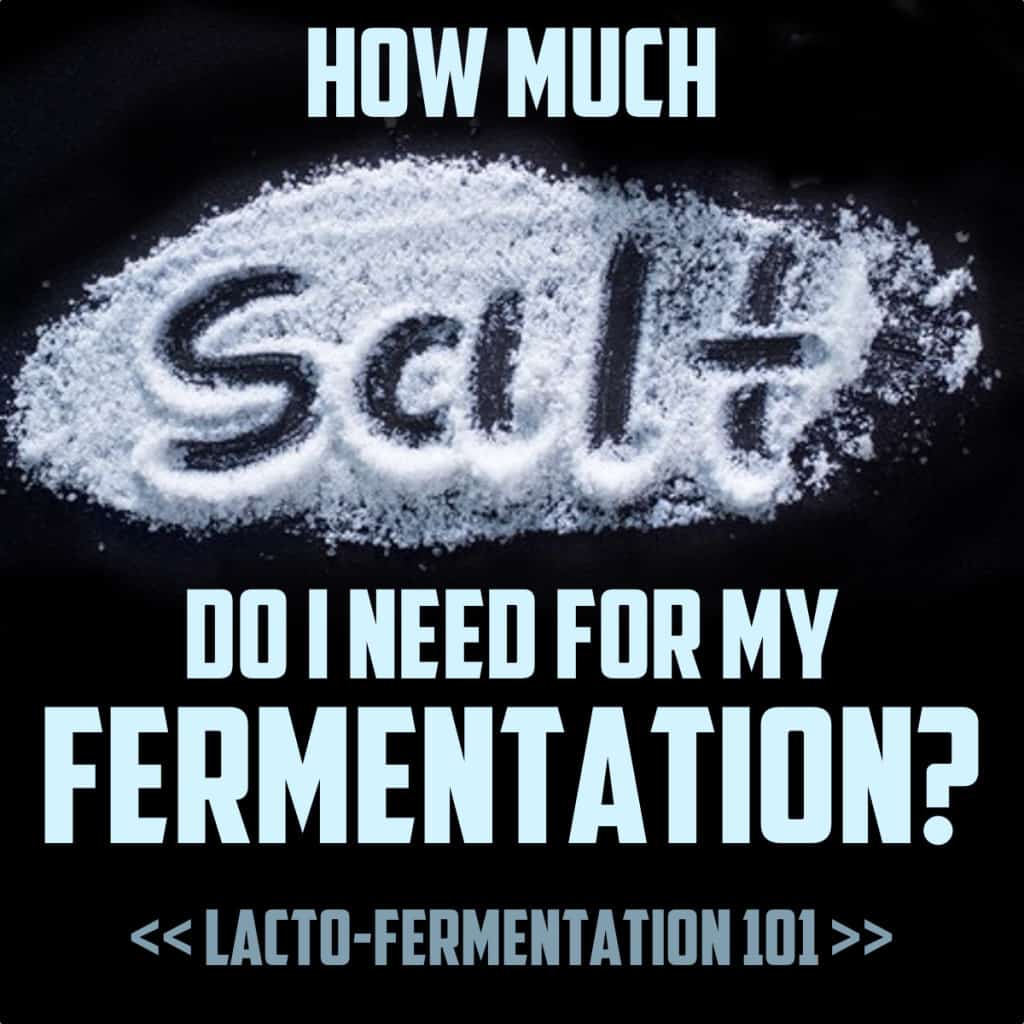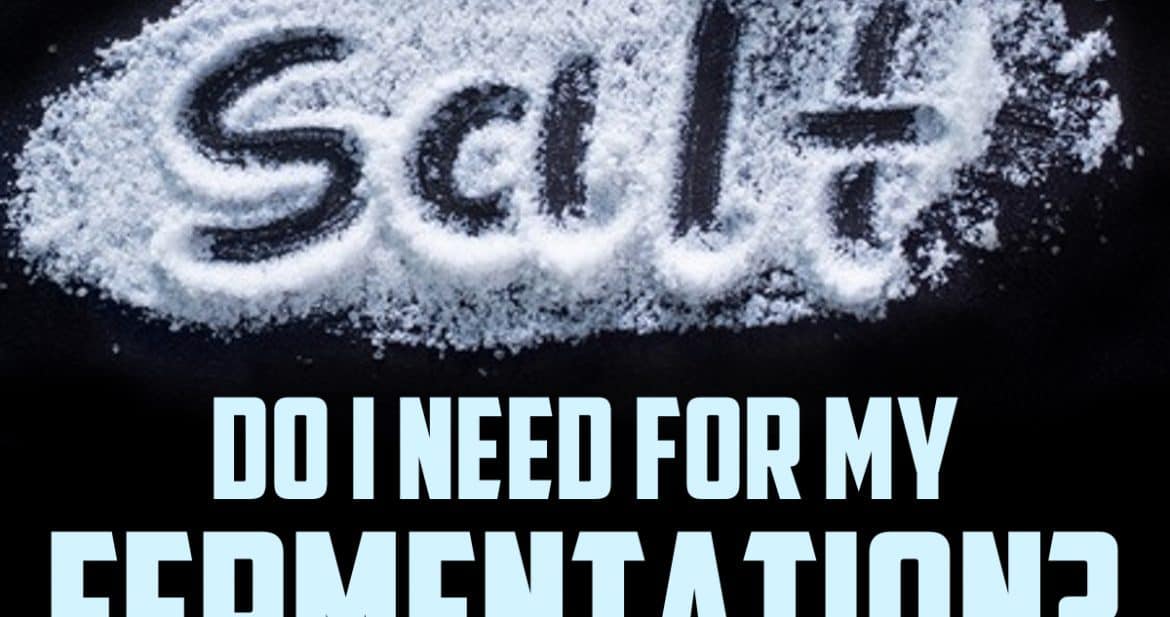Controlled fermentation is one of the easiest, cheapest, lowest-tech ways to preserve the harvest. With nothing more than salt, water and the microbes already living on your vegetables, you can turn highly-perishable cucumbers into long-lasting pickles, raw cabbage into more-digestible sauerkraut, and churn out dilly beans without ever heating up the canning kettle.
Plus…yum! Fermented food tastes delicious. And if you disagree you can give all your coffee, cheese, beer, wine, sourdough bread, miso, pickles and sauerkraut to me.
The only thing that can be a bit confusing is the salt. What kind? How much? Alone or in water? Recipes that say stuff like “add some salt to your sauerkraut” don’t help matters, and I’ll admit that I’m as guilty of publishing such fermentation vagaries as anyone.
The reason folks comfortable with fermenting foods at home tend to be a little loosey-goosey about this stuff is that we’ve learned that many factors affect a fermenting preserve: salinity – yes – but also temperature, volume, added spices and herbs, etc. So a certain amount of “going by feel” becomes second nature after awhile.
Thankfully, fermentation is quite forgiving. A little less or a little more salt is unlikely to ruin your ferment, so such intuitive measuring usually works out just fine.
But that’s not much help to folks who are just starting out.
So I’m going to lay out some easy guidelines you can follow for creating dry and wet brines for fermented foods. But know that you can tweak these ratios based on your kitchen and your palate as needed. They are guidelines, and once you understand why they are what they are, you can experiment with more confidence.

Nature’s Pickling
The concentration of salt in our brine helps to set up an environment in which the right microbes thrive – we want a dominant colony of the bacteria that make tasty ferments, not the ones that rot or make food smell like a 15 year old boy’s gym socks.
Nearly all of the microbes we want to encourage come from a large family called Lactic Acid Bacteria. You can call them LAB for short. The LAB chow down on sugars and starches and excrete – you guessed it! – lactic acid. This lactic acid pushes the pH of the ferment lower and lower, preserving it.
Lacto-fermentation can reasonably be called “nature’s pickling” because of the pH lowering effect of this lactic acid, despite the fact that there is no vinegar involved in lacto-fermentation. The acidification of the ferment is a byproduct of creating the right environment for the right microbes.
The LAB microbes are uniquely tolerant of a high salt environment. They can’t outcompete the rot-and-gym-socks microbes in a fair fight, but if we stack the deck in their favor with a little salt, they can rapidly dominate their environment and make preserved deliciousness happen.
Brine Percentages and What They Do To A Ferment
The amount of salt dissolved in water determines the strength of the brine. More salt = stronger brine. Less salt = weaker brine. In fermentation we might use anything from a 2% to a 10% brine solution.
Beneficial LAB microbes won’t outcompete their teeny mortal enemies in a brine less than 1% salt. 10% salt will tend to leave things so deeply salty they might need a soaking in fresh water to be edible. And at a 10% brine, even the LAB are going to struggle.
Weaker Brine
- Does not suppress microbial action as effectively as a stronger brine.
- Allows for faster fermentation because the lactobacillus and other beneficial microbes are not as suppressed. Good in cooler weather when fermentation needs help to get started.
- Has a greater chance of spoilage, mold, and other nastiness because the harmful microbes are not suppressed, either.
- Less salt is less preserving of cell wall strength, so ferments can end up with a softer texture, particularly if they are fermented warm.
Stronger Brine
- Minimizes the risk of a failed ferment (mold, harmful bacteria outcompeting lactobacillus, etc.)
- Slows fermentation which can be beneficial in warm weather and when more complex flavors are desired.
- Too strong a brine can kill off the saline-tolerant beneficial microbes, leading to a failed ferment.
- More salt strengthens cell walls, so vegetables in a stronger brine tend to stay more firm and crisp.
As you can see, brine strength is always a balancing act between retarding the growth of non-desireable microbes, encouraging the growth of the beneficial microbes which will ferment our food, and creating a desirable flavor and texture profile.
Make Brine Easy: Work In Metric
Look, I know many of my readers are in the United States, and we are proud to be holding out against the obviously superior logic of a base-ten measurement system. But if you can work in metric this whole brine thing is going to be so easy.
Here’s an example.
How many tablespoons of salt does is take to turn a quart of water into a 3% brine solution? Who the hell knows? And unless we specify an exact salt, there is no exact answer, because a tablespoon of kosher salt is far lighter than a tablespoon of fine pickling salt. Different salts measured by volume can have a 60% difference in their weight!
Now, how many grams of salt does it take to make a 3% brine in 1000 milliliters (1 liter) of water? Well, 1000 x .03 = 30. So it takes 30 grams. No matter what kind of salt you are using, you need 30 grams. Always. Forever. See how easy this is in metric?
Different Vegetables Need Different Strength Brines
The sweet spot for most ferments is a 2% – 3% brine solution, with a few vegetables benefiting from stronger brine, up to 5% salinity.
Firm vegetables like carrots, beets, turnips, onions, garlic, asparagus, and green beans can all be fermented successfully with a 2 to 3% brine. That’s 20 to 30 grams of salt for each liter of water.
Cucumber pickles are very perishable and very full of water (which eventually dilutes the brine), and so need a bit more salt to ferment reliably. A 5% brine, or 50 grams of salt per liter of water, is good for cucumber pickles. Peppers are more prone to mold than many other vegetables, so they are typically fermented in a slightly stronger brine, too. A 3% to 5% brine usually works well for whole or large-chunk peppers.
A 10% brine is used for highly perishable foods, fermentation in hot weather, or for situations where food can’t be kept refrigerated after fermentation. This is beyond the scope of this article or my personal knowledge, but apparently feta, fish sauce, and other protein foods are typically preserved in a 10% brine solution.
Again, these are guidelines – if your ferments are prone to mold, if you are fermenting in hot weather, or if your ferments end up more soft than you like, you should bump up the salinity level in your ferments.
What About Sauerkraut and Salsa?
Many ferments aren’t submerged in a pre-mixed wet brine but rely on the moisture in the veg to create a brine when mixed with salt. Salt draws moisture from the cells of the shredded vegetable.
This is called dry-brining or self-brining. Ferments prepared this way, without additional water, should be mixed to about 2% salt.
Sauerkraut is the most well-known example of this dry-brined style, but salsas, chutneys, relishes and many other finely chopped or shredded vegetables or condiments that make their own juice can all be fermented in this way at about 2% salinity by weight.
The best way to do this, again, is by weight. If you have a kilogram of prepared vegetable, adding 20 grams of salt will bring your ferment to a 2% total salinity. This works out to 45 grams of salt for each 5 pounds of vegetables, or 9 grams of salt for each pound.
That’s it! Now go forth and ferment with confidence!
526
This is great! I like the ranges and reasoning. I’ve been fermenting for a while, but just using recipes found on the web or guesswork. Right now I’m making a bunch of kvass with beets and onions – it’s salty now, but when I drink it, I strain out all the solids, dilute with water and it tastes really good.
Okay, I’ll ask the really ignorant question: how do you weigh salt? I have a kitchen scale, but it seems like it hold bigger things (apples) and wouldn’t deal with tiny amounts (a single gram). Do you have several scales? Do you never use measuring cups?
My kitchen scale toggles back and forth between grams/kg and oz/lbs. I’ll do a conversion sheet for folks who prefer to measure and get it up next week.
Also, if you really like your kitchen scale, you could describe that. Although I almost never ever buy *anything*, I’ve Craigslisted an apple peeler/corer, and I’ve amazon purchased the Ringer, all because of you.
Just sayin’, a post on how you measure in your kitchen might be an interesting post for us mere mortals.
I wish I could recommend a really great kitchen scale. I am currently using this one, and so far it’s been great. I used to swear by the Salter brand scales, but the last one I had fell apart (literally!) after only 2 years or so. Don’t get this one – I saw it for a good price, looked at all the reviews and thought it must be awesome! I was wrong. The markings on the scale rubbed off the first time I used the scale from just the pressure of my fingertips. The company replaced that scale with a new one, and the same thing happened to the second one. It was just a cheaply made POS.
Wow, thank you for this. I’ve fermented some but not a lot and always have questions about the amount of salt. Now I feel like I understand the whole thing better. If this is any indication of how excellent your book is going to be I am really excited for it.
Thank you! That’s a wonderful thing to hear!
I am about at my wits end with folks insisting that the addition of whey is the way to go (pun intended). It is so rare to need a “starter culture” when you have fresh, wholesome raw veg, but so many bloggers insist on including out in their recipes. Anyway, good, encouraging write-up, Erica.
I agree, we have dairy allergies at our house, so I can’t possibly use whey, and have great success with plain salt anyway.